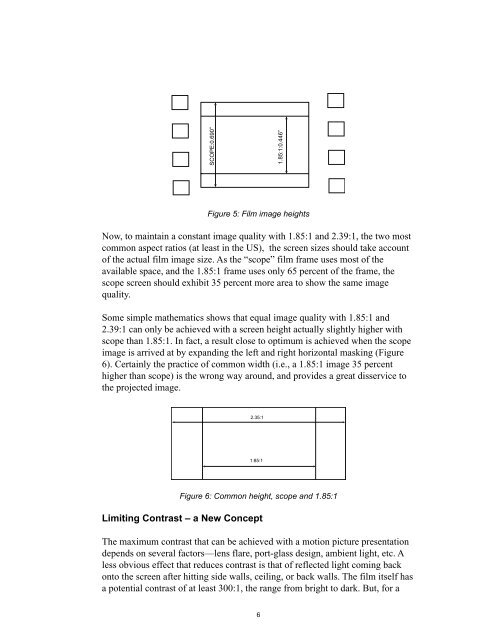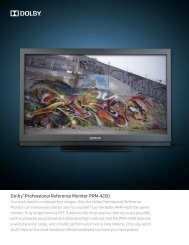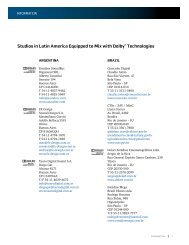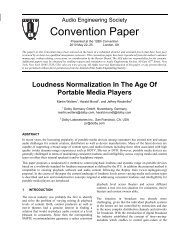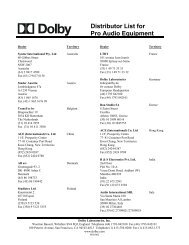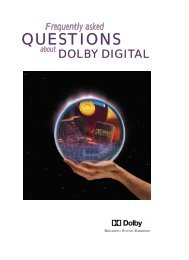Screen Sizes Impact on Picture and Sound - Dolby Laboratories Inc.
Screen Sizes Impact on Picture and Sound - Dolby Laboratories Inc.
Screen Sizes Impact on Picture and Sound - Dolby Laboratories Inc.
You also want an ePaper? Increase the reach of your titles
YUMPU automatically turns print PDFs into web optimized ePapers that Google loves.
SCOPE:0.690”<br />
6<br />
1.85:1:0.446”<br />
Figure 5: Film image heights<br />
Now, to maintain a c<strong>on</strong>stant image quality with 1.85:1 <strong>and</strong> 2.39:1, the two most<br />
comm<strong>on</strong> aspect ratios (at least in the US), the screen sizes should take account<br />
of the actual film image size. As the “scope” film frame uses most of the<br />
available space, <strong>and</strong> the 1.85:1 frame uses <strong>on</strong>ly 65 percent of the frame, the<br />
scope screen should exhibit 35 percent more area to show the same image<br />
quality.<br />
Some simple mathematics shows that equal image quality with 1.85:1 <strong>and</strong><br />
2.39:1 can <strong>on</strong>ly be achieved with a screen height actually slightly higher with<br />
scope than 1.85:1. In fact, a result close to optimum is achieved when the scope<br />
image is arrived at by exp<strong>and</strong>ing the left <strong>and</strong> right horiz<strong>on</strong>tal masking (Figure<br />
6). Certainly the practice of comm<strong>on</strong> width (i.e., a 1.85:1 image 35 percent<br />
higher than scope) is the wr<strong>on</strong>g way around, <strong>and</strong> provides a great disservice to<br />
the projected image.<br />
2.35:1<br />
1:85:1<br />
Figure 6: Comm<strong>on</strong> height, scope <strong>and</strong> 1.85:1<br />
Limiting C<strong>on</strong>trast – a New C<strong>on</strong>cept<br />
The maximum c<strong>on</strong>trast that can be achieved with a moti<strong>on</strong> picture presentati<strong>on</strong><br />
depends <strong>on</strong> several factors—lens flare, port-glass design, ambient light, etc. A<br />
less obvious effect that reduces c<strong>on</strong>trast is that of reflected light coming back<br />
<strong>on</strong>to the screen after hitting side walls, ceiling, or back walls. The film itself has<br />
a potential c<strong>on</strong>trast of at least 300:1, the range from bright to dark. But, for a


